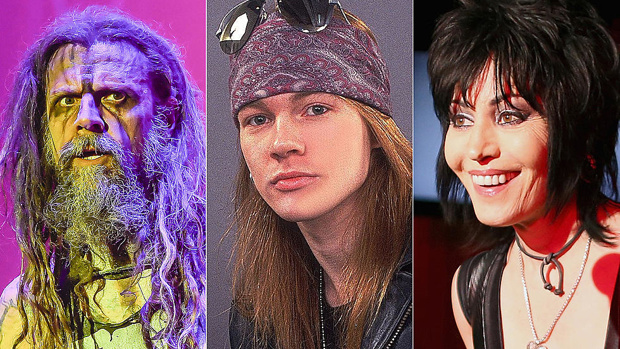10 Rockers Who Legally Adopted Their Stage Names
- Publish Date
- Tuesday, 14 March 2023, 1:41PM

Everyone wants to have a name that defines them, and rock stars are no different. Thus, many of them create new ones to make their professional personas more exciting and representative.
Obviously, most musicians merely adopt their secondary moniker for publicised purposes, symbolically becoming someone else for their art without actually replacing who they used to be. Every so often, though, they’ll go a step further by making the change in a court of law.
Case in point: the 10 rockers on this list. Whether they did it before or after finding fame, their stage names are indeed legally sanctioned.

Queen's Freddie Mercury
Born Farrokh Bulsara, Freddie Mercury suffered from self-doubt. As former Queen bandmate Brian May explained, he “faced up to his insecurities by building himself in the way he wanted to be,” which included transforming himself into “the outside . . . warrior” as much as possible.
That vow necessitated a revised designation, and just as Queen were beginning, Mercury – who’d already switched his forename to Freddie – felt so inspired by a lyric to their song “My Fairy King” (Mother Mercury / Look what they’ve done to me) that he modified his surname, too. Reportedly, he was singing about his mother.
Joan Jett
Like Jack White, Joan Marie Larkin adopted her new tag – Joan Jett – prior to becoming famous. Particularly, she picked it around the age of 16, when her parents divorced and she began working at Rodney Bingenheimer’s English Disco on Sunset Boulevard.
That said, she chose “Jett” because it fit the rock star persona she was going for (which also involved “black leather, black eyeliner, and a black shag haircut modelled after American rocker Suzi Quatro”). By the time The Runaways disbanded and she started the Blackhearts in the early ‘80s, she’d lawfully become Jett to fully celebrate her triumphant identity.
W. Axl Rose
When he was young, William Bruce Rose Jr. took the last name of his stepfather, Stephen L. Bailey. As a raucous teenager, however, he started going by W. Rose, and when he launched LA band AXL, he elected to embrace the nickname as well.
Former Hollywood Rose guitarist Chris Weber clarifies, “Axl called the name of the band AXL and then slowly but surely, he wanted to take on that name for himself. . . . Then he reinvented himself.” When it was time for G N' R to sign with Geffen in 1986, he rightfully became W. Axl Rose.
Rob Zombie
Rob Zombie is inarguably one of the coolest names in popular music, and definitely more “metal” than Robert Bartleh Cummings. Unsurprisingly, Cummings was an avid horror fan as a kid – not to mention a carnie – and he grew up admiring figures such as Alice Cooper and Bela Lugosi.
Obviously, he named his breakout band – White Zombie – after Lugosi’s 1932 genre classic, yet he was credited as Rob “Dirt” Straker on their first two LPs: Soul-Crusher and Make Them Die Slowly. With 1989’s God of Thunder EP, though, he converted to Rob Zombie, and in 1996, he got it licitly documented.
Alice Cooper
Around 1968, burgeoning Arizona high school band The Nazz (fronted by Vincent Damon Furnier) realized that Todd Rundgren used their name first. So, they opted to alter theirs to Alice Cooper because it presented an “innocuous and wholesome” juxtaposition to “the ‘shock rock’ image [they] were developing.”
Of course, Furnier had ostensibly become Alice, too (in multiple ways), and after the group broke up, he decided to lawfully keep the title in order to avoid judicial issues with the release of his debut solo album, 1975’s Welcome to My Nightmare. To date, he says, only Keith Richards calls him Vince.
Nikki Sixx
In 1978 – three years before co-founding Motley Crüe – bassist Frank Carlton Serafino Feranna Jr. formed heavy metal act London and transformed into Nikki Sixx. In a late 2021 chat with The Project, Sixx specified that the negative “messaging” he heard about his parents growing up stuck with him, and when he “started to become of age” and join bands, he no longer wanted to “carry [his] dad’s name.”
He continues, “So I changed my name to Nikki Sixx legally and said, 'I'm moving forward.' . . . I actually did manifest a new life."
Mick Mars
Moving onto another Motley Crüe member, there’s co-founder Mick Mars (born Robert Alan Deal). As the story goes, he originally fell in love with country music – plus The Beatles and The Rolling Stones – and spent much of the ‘70s playing in various California rock groups, including Whitehorse. (Occasionally, he’d call himself Zorky Charlemagne, too.)
However, he eventually decided that he needed a fresh approach musically and visually, so he opted to look for new opportunities while reimagining himself. Part of that meant taking on the name of Whitehorse’s singer, Micki Mars, and advertising himself as a “loud, rude, aggressive guitarist.”
Paul Stanley
For the first 20 or so years of his life, KISS frontman Paul Stanley was known as Stanley Bert Eisen. During his upbringing, he was taunted “for his Jewish heritage and ear-warped microtia,” so when the chance arrived to be figuratively reincarnated as Paul Stanley – alongside his Kiss persona, Starchild – he jumped at it.
In a now-unavailable 2018 YouTube video titled “Gene & Paul losing weight and changing their names for marketing reasons,” Stanley asserts that he was influenced by Paul McCartney and Paul Rodgers, and that circa 1974 (when Kiss’ debut LP came out), he made the moniker legal.
(Prince Symbol)
True, he was Prince Rogers Nelson at birth, and he always went by Prince — that is, until his 35th birthday on June 7, 1993. In one of his most fascinatingly eccentric moves, he issued a statement illuminating his choice to formally represent himself by the gender-spliced image used on the cover of 1992’s Love Symbol: “It is an unpronounceable symbol whose meaning has not been identified. It’s all about thinking in new ways, tuning in 2 a new free-quency.”
The rumor was that he did it out of spite for Warner Bros. and he reverted back to Prince in 2000.
Jack White
This may be bending the rules since it happened before The White Stripes began, but White’s never undone it, so we think it counts. Long story short, John Anthony Gillis married Meg White in 1996, taking her surname, and by the time they divorced in 2000, he’d become such a recognized brand that he chose to retain it.
There were business reasons, too, such as the fact that the couple initially passed themselves off as siblings. While it’s uncommon for men to take their wives’ surnames, it’s certainly happened before (for example, John Lennon added Ono as a middle name in 1969.)
This article was first published on loudwire.com
Take your Radio, Podcasts and Music with you

